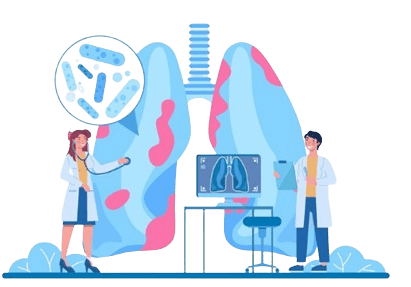Robotic Thoracic Surgery in Mumbai
Robotic Thoracic Surgery in Mumbai is available at Nanavati Max Super Speciality Hospital under the directorship of Dr. George Karimundackal, a leading thoracic surgeon.
The robotic thoracic surgery program at Nanavati Max Super Speciality Hospital is extremely well developed and caters to a number of malignant and benign conditions of the chest. The hospital is equipped with a state-of-the-art, Da Vinci Xi robotic system.
Learn About RATS: Dive deeper into the details of Robotic Assisted Thoracic Surgery and its advantages.

About Robotic Assisted Thoracic Surgery (RATS)
The robotic approach has several advantages over the conventional open approach to thoracic surgery. These include improved vision and increased dexterity for complex manoeuvres in a limited cavity. This makes surgery more precise and less invasive. The pinnacle of medical innovation, Robotic Thoracic Surgery combines precision and advanced technology for optimal patient outcomes.
Studies have proven the advantage conferred by robotic surgery over open surgery in terms of decreased blood loss during the procedure, less post-operative pain, shorter hospital stay and earlier return to routine activity. The robotic approach has been validated for lung, esophageal and thymic surgery.
Think about this: A less invasive procedure means less post-operative pain.
Choose excellence in robotic-assisted thoracic procedures. Book an Appointment Now!
About the procedure

The surgeon inserts a 3D high-definition camera through a small incision, which helps her/him visualize the thoracic cavity and the organ of interest. The remaining instruments (3-4) are also placed under vision within the thoracic cavity via 1 cm incisions in the rib spaces.
The assistant surgeon remains by the patient’s side throughout the procedure. The movements made by the surgeon at the console are replicated precisely by the robotic instruments at the operative site, allowing her/him to complete the operative procedure with magnified vision and superior instrument control within a limited cavity. The diseased organ is removed through any one of the previously made incisions, avoiding large cuts and rib spreading.
Now let’s deep dive into
Types of Robotic Thoracic Procedures
Dr George Karimundackal, Director – Surgical Oncology (Thoracic Surgery) and his team at Nanavati Max Specialty Hospital are qualified to perform a wide range of robotic thoracic procedures.
Robot-assisted lobectomy, segmentectomy, and other lung resections-
In this procedure, the surgeon utilizes the robot to remove the lobes or segments of the lung along with the affected lymph nodes.
Robot-assisted thymectomy–
In this procedure, when performed with robotic assistance, the surgeon can remove the thymus gland in its entirety with improved visibility, precision and smaller incisions. This avoids a large incision down the patient’s breast bone.
Robot-assisted esophagectomy-
In this procedure, the surgeon uses the robot to dissect the esophagus and the cancer-affected lymph nodes. The robot allows greater precision and preservation of nerves, ensuring voice preservation and fewer lung complications. The post-operative recovery is smoother and pain-free.
| Cancer | Low grade Tumors | Benign Conditions |
| Cancer of the lung | Schwannoma | Interstitial lung diseases |
| Cancer of the esophagus | Neurogenic Tumors | Bronchiectasis |
| Thymoma | Thymectomy for myasthenia gravis | |
| Mediastinal Tumors | Hyperhydrosis reversal |
Understand Recovery: Learn about the smooth recovery process post robotic thoracic surgery.
Transform your thoracic health with precision and care. Book an Appointment Now!
Recovery after Robotic thoracic surgery
The recovery after robotic thoracic surgery is relatively smooth. After a short observation period in the postoperative recovery ward, most patients are shifted back to the room. Depending upon the type of surgery and recovery, the patient will be discharged in two or three days post-procedure.
Post robotic esophagectomy, the patient is kept in the ICU/recovery for a day and is discharged by day 8 once the patient is on full oral diet. Post-procedure, the patients are looked after by our able team consisting of critical care specialists, pulmonologists, physiotherapists and specially trained nurses, ensuring a smooth and speedy recovery.
On returning home, most patients can go about their normal routine. Depending on the type of surgery, many patients can return to work as early as a week from discharge. Early return to routine daily life activities is one of the advantages of robotic surgery.
Cost of Robotic thoracic surgery
Cost of robotic surgery is determined by the complexity of the procedure, the number of instruments used and hospital and room category the patient chooses.
Read FAQs: Get your questions about robotic thoracic surgery answered.
Frequently Asked Questions
Yes, robotic thoracic surgery is considered safe if performed by a skilled surgeon with prior experience in robotic-assisted procedures. The surgeon performs the entire surgery by operating through robotic arms via the console. The bedside assistant helps the surgeon during the procedure.
Robotic thoracic surgery is preferred over traditional open surgery as it requires smaller incisions, leading to reduced trauma to the surrounding tissues and faster recovery times. The surgeon operates using robotic arms through a console, which offers enhanced visualization and precision in movements. On the other hand, traditional open surgery requires larger incisions, leading to more surgical trauma and, hence, a longer recovery period.
Thoracic surgeons have received special training for robotic thoracic surgery and hands-on experience using the robotic-assisted system. They participate in proctoring programs and ensure their proficiency in performing these procedures. Hence, choosing a thoracic surgeon with relevant experience in robotic thoracic surgery is important.
A thoracic surgeon will evaluate the patient, their medical history and the results of certain diagnostic tests to ascertain their suitability for robotic thoracic surgery. Hence, the eligibility for robotic thoracic depends upon various factors, and the surgeon can recommend a suitable procedure for your condition.


